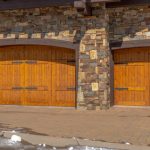
1. Frozen Garage Door:
One of the most common winter problems is a frozen garage door. When temperatures drop below freezing, moisture can accumulate and freeze on the door’s components, including the tracks, rollers, and springs. This can prevent the door from opening or closing properly. Attempting to force the door open in this situation can lead to further damage.
2. Contraction and Expansion:
Extreme temperature fluctuations in winter can cause the metal components of your overhead garage door to expand and contract. This can result in misalignments, which affect the door’s smooth operation. Misaligned tracks can cause the door to become crooked or get stuck midway. It is important to address any misalignment issues promptly to avoid causing more severe damage.
3. Broken Springs:
Cold weather can put added stress on the springs of your garage door. If they are already worn or aging, the colder temperatures can cause them to break. Broken springs not only make it difficult to open or close the door but also pose a safety risk. It is crucial to get the springs replaced by a professional as soon as possible to prevent accidents or further damage to the door.
4. Malfunctioning Remote Control:
The batteries in your garage door remote control can be weakened by cold temperatures, causing them to lose power or stop working altogether. This can be quite inconvenient and frustrating, especially when you are rushing to leave in the morning or coming back home late at night. To avoid this issue, it is advisable to keep spare batteries handy and ensure regular maintenance of your remote control.
5. Insufficient Lubrication:
Cold weather can cause lubricants to thicken or solidify, resulting in insufficient lubrication for the moving components of your garage door. This can lead to increased friction, which can cause wear and tear on the door’s parts. Regularly lubricating the tracks, rollers, hinges, and springs with a lubricant suitable for cold weather can help prevent this problem.
6. Seal and Weatherstripping Damage:
Winter storms and freezing temperatures can cause the seal and weatherstripping around your garage door to crack, become brittle, or even detach. This compromises the insulation and can allow cold air, snow, and moisture to enter your garage. It is important to inspect the seal and weatherstripping regularly and replace any damaged or worn-out parts to maintain proper insulation and protect your belongings from winter weather.
7. Ice Buildup:
Ice accumulations can occur at the bottom of your garage door, called the door’s seal. This happens when snow or rainwater freezes and gets trapped there. Ice buildup can prevent the door from closing completely, leaving gaps that allow cold air and moisture to enter your garage. It also poses a safety hazard as it increases the risk of slips and falls. Removing ice carefully with a suitable tool or using ice melt products can help alleviate this issue.
Summary
Winter can present various challenges to your overhead garage door in Rancho Cordova. Frozen components, misalignment, broken springs, malfunctioning remotes, insufficient lubrication, seal and weatherstripping damage, and ice buildup are common problems faced by homeowners. Regular maintenance, prompt repairs, and taking necessary precautions can help minimize these issues and ensure that your garage door functions properly throughout the winter season. If you are experiencing any of these problems with your overhead garage door, it is recommended to consult a professional garage door repair service in order to address the issues effectively and safely.

